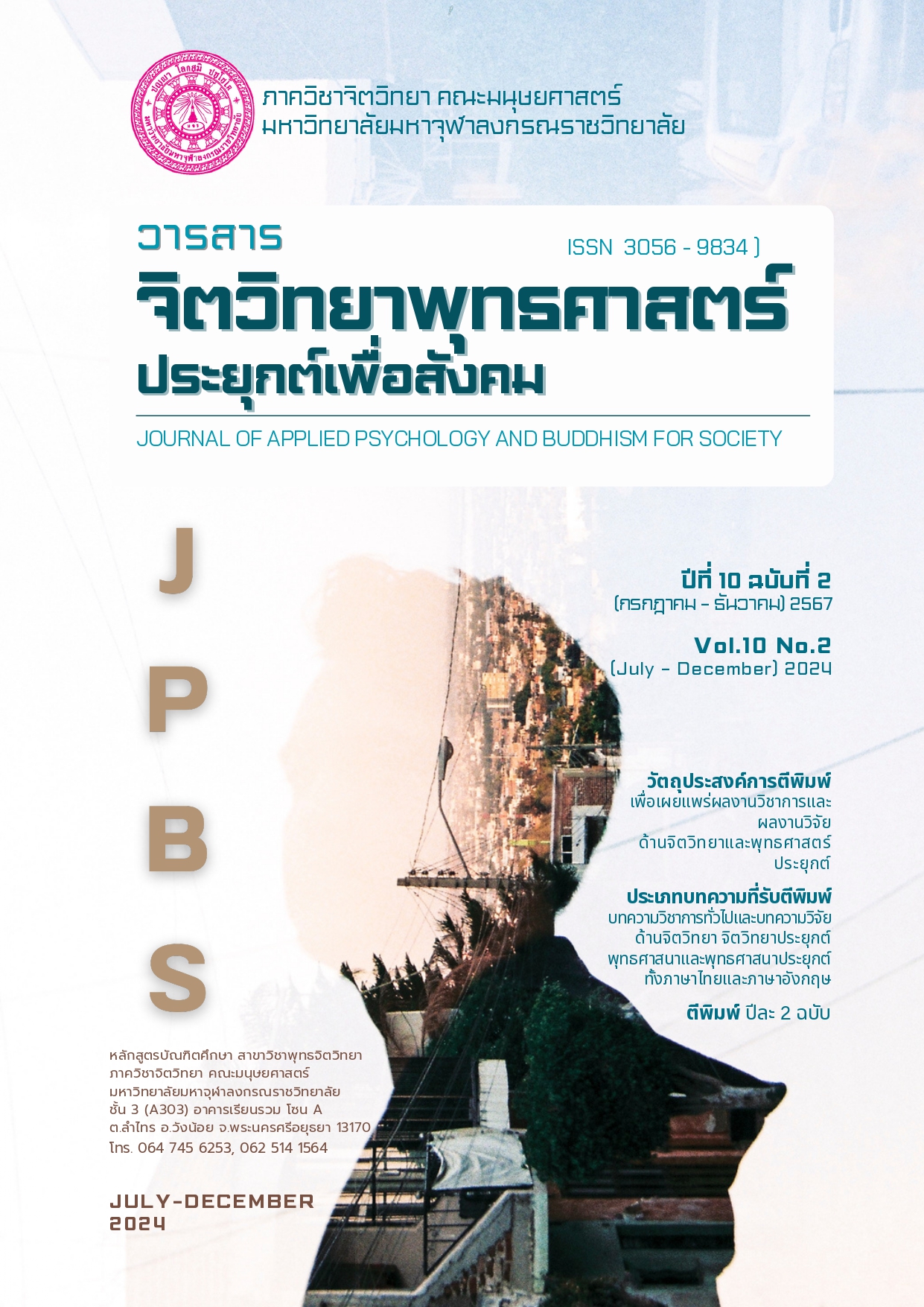A motivation for Improving the Quality of Life by Buddhist Psychology of Mon People Labor in Thailand
Keywords:
Motivation, Development, Quality of Life, Buddhist Psychology, Labor, Mon PeopleAbstract
This research aims to: 1. Study the motivation for improving the quality of life based on Buddhist psychology; 2. Investigate the methods of motivating the improvement of the quality of life according to Buddhist psychology among the Mon ethnic group working in Thailand; and 3. Propose guidelines for motivating the improvement of the quality of life according to Buddhist psychology for the Mon ethnic group working in Thailand. The research employed a mixed-methods approach divided into three phases. Phase 1 utilized qualitative research, conducting in-depth interviews with 15 key informants. Phase 2 involved quantitative research using questionnaires administered to a sample of 485 Mon workers in Thailand. The data were analyzed using descriptive statistics, including percentages, means, and standard deviations. Phase 3 involved focus group discussions to present the research findings to experts in the field.
The findings revealed that: 1. Motivation for improving the quality of life based on Buddhist psychology consists of four key Buddhist principles: the principle of “Ditthadhammikatha” (Virtues conducive to benefits in the present),Maslow's hierarchy of needs theory, and the WHOQOL organizational quality of life framework; 2. The methods of motivating the improvement of the quality of life among the Mon ethnic group working in Thailand, based on Buddhist psychology, include: 1) Motivation for improving physical quality of life; 2) Motivation for improving safety; 3) Motivation for improving social quality of life; 4) Motivation for improving moral quality of life; and 5) Motivation for improving ethical quality of life. The most significant statistical finding in terms of motivation for quality of life improvement was related to income and job security, followed by work environment and relationships with coworkers; 3. The proposed guidelines for motivating the improvement of the quality of life of the Mon ethnic group working in Thailand include promoting education, developing skills and vocational training, and establishing appropriate support systems to enhance motivation and the quality of life for Mon workers in Thailand as well as other foreign workers in the country.
References
กรมศิลปากร. (2558). ชนชาติมอญ (พิมพ์ครั้งที่ 1). กรุงเทพฯ : กรมศิลปากร.
กรมสุขภาพจิต. (2563). กระทรวงสาธารณสุข. สืบค้น 8 ธันวาคม 2566, จาก https://www. dmh.go.th/test/whoqol/
กองสวัสดิการแรงงาน. (2560). คุณภาพชีวิตการทำงาน (Quality of work life). อนุสารแรงงาน, 11(4), 17-22.
กัญญารัตน์ ทุสาวุธ. (2562). คุณภาพชีวิตแรงงานข้ามชาติ กรณีศึกษาแรงงานสัญชาติพม่า เขตตำบลมหาชัย อำเภอเมือง จังหวัดสมุทรสาคร (ศิลปศาสตรมหาบัณฑิต การเมืองและยุทธศาสต์การพัฒนา) สถาบันบัณฑิตพัฒนาบริหารศาสตร์. กรุงเทพฯ.
ป. อ. ปยุตฺโต (พระพรหมคุณาภรณ์). (2551). พจนานุกรมพุทธศาสตร์ฉบับประมวลธรรม. กรุงเทพฯ : โรงพิมพ์มหาจุฬาลงกรณราชวิทยาลัย.
“_______”. (2551). พจนานุกรมพุทธศาสน์ฉบับประมวลศัพท์ (พิมพ์ครั้งที่ 17). กรุงเทพฯ : โรงพิมพ์แห่งจุฬาลงกรณ์ราชวิทยาลัย.
“_______”. (2555). ธรรมนูญชีวิต (พิมพ์ครั้งที่ 119). กรุงเทพฯ : โรงพิมพ์พระพุทธศาสนาของธรรมสภา.
พระไพศาล วิสาโล. (2564). คุณภาพชีวิตตามแนวพุทธ. กรุงเทพฯ : สำนักพิมพ์อมรินทร์.
พระมหาสมชาย สิริจนฺโท (หานนท์). (2548). พุทธธรรมเพื่อการพัฒนาคุณภาพชีวิตตามแนวทางของพระเทพวรคุณ (สมาน สุเมโธ) (พุทธศาสตรมหาบัณฑิต พระพุทธศาสนา). มหาวิทยาลัยมหาจุฬาลงกรณราชวิทยาลัย. กรุงเทพฯ.
มหาจุฬาลงกรณราชวิทยาลัย. (2539). พระไตรปิฎกภาษาไทย ฉบับมหาจุฬาลงกรณราชวิทยาลัย. กรุงเทพฯ : โรงพิมพ์มหาจุฬาลงกรณราชวิทยาลัย.
Central Statistical Organization, The Republic of the Union of Myanmar. (2024). Myanmar Population and Housing Census 2022. Retrieved September 8, 2023, from https://www.csostat.gov.mm/
Guo, B. et al. (2021). The Relationship between Achievement Motivation and Job Performance among Chinese Physicians: A Conditional Process Analysis. Retrieved June, 17 2024, from https://pubmed.ncbi.nlm.nih.gov/33928157/
Kristiani, S.R., Hidayati, T., & Kusumawardani, A. (2021). The Influence of Achievement Motivation and Job Satisfaction on Employee Performance mediated by Affective Commitment for Development Planning and Supervision of the Regional Revenue Agency of Kutai Kartanegara Regency Officer. International Journal of Business and Management Invention, 10(11), 1-7.
Luffman, J.M., Bulleen, C.V., Liano, A.D., McLeed, P.K., Nash, E.O., & Neuman, C.C. (2004). Information technology resources management. Upper Saddle River, NJ: John & Sons Press.
Lui, B-C. (1975). Quality of life: Concept, Measure and Result. The American Journal of Economics and Sociology, 34(1), 12.
McClelland, D.C. (1953). The Achievement Motive. New York: Appleton Century Crofts.
Ower, E., Bollinger, M.E., & the WHOQOL Group. (1998). WHOQOL: The World Health Organization Quality of Life Assessment. Geneva: World Health Organization.
Power, E., Bollinger, M.E., & the WHOQOL Group. (1998). WHOQOL: The World Health Organization Quality of Life Assessment. Geneva, Switzerland: World Health Organization.
Schuler, R.S. et al. (2022). The Influence of Work Behavior, Achievement Motivation, and Work Competence on Employee's Performance: a Newest Evidence. Journal of Management, 12(2), 1463-1472.
Downloads
Published
How to Cite
Issue
Section
Categories
License
Copyright (c) 2024 Journal of Applied Psychology and Buddhism for Society

This work is licensed under a Creative Commons Attribution-NonCommercial-NoDerivatives 4.0 International License.





